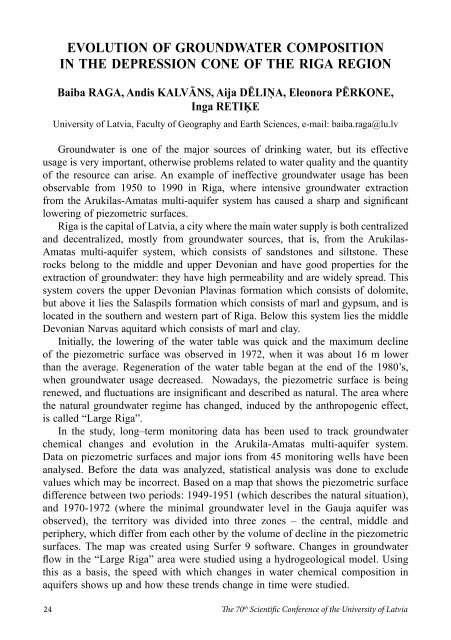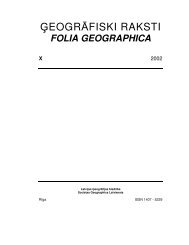Section âGroundwater in Sedimentary Basinsâ - Latvijas UniversitÄte
Section âGroundwater in Sedimentary Basinsâ - Latvijas UniversitÄte
Section âGroundwater in Sedimentary Basinsâ - Latvijas UniversitÄte
Create successful ePaper yourself
Turn your PDF publications into a flip-book with our unique Google optimized e-Paper software.
EVOLUTION OF GROUNDWATER COMPOSITIONIN THE DEPRESSION CONE OF THE RIGA REGIONBaiba RAGA, Andis KALVĀNS, Aija DĒLIŅA, Eleonora PĒRKONE,Inga RETIĶEUniversity of Latvia, Faculty of Geography and Earth Sciences, e-mail: baiba.raga@lu.lvGroundwater is one of the major sources of dr<strong>in</strong>k<strong>in</strong>g water, but its effectiveusage is very important, otherwise problems related to water quality and the quantityof the resource can arise. An example of <strong>in</strong>effective groundwater usage has beenobservable from 1950 to 1990 <strong>in</strong> Riga, where <strong>in</strong>tensive groundwater extractionfrom the Arukilas-Amatas multi-aquifer system has caused a sharp and significantlower<strong>in</strong>g of piezometric surfaces.Riga is the capital of Latvia, a city where the ma<strong>in</strong> water supply is both centralizedand decentralized, mostly from groundwater sources, that is, from the Arukilas-Amatas multi-aquifer system, which consists of sandstones and siltstone. Theserocks belong to the middle and upper Devonian and have good properties for theextraction of groundwater: they have high permeability and are widely spread. Thissystem covers the upper Devonian Plav<strong>in</strong>as formation which consists of dolomite,but above it lies the Salaspils formation which consists of marl and gypsum, and islocated <strong>in</strong> the southern and western part of Riga. Below this system lies the middleDevonian Narvas aquitard which consists of marl and clay.Initially, the lower<strong>in</strong>g of the water table was quick and the maximum decl<strong>in</strong>eof the piezometric surface was observed <strong>in</strong> 1972, when it was about 16 m lowerthan the average. Regeneration of the water table began at the end of the 1980’s,when groundwater usage decreased. Nowadays, the piezometric surface is be<strong>in</strong>grenewed, and fluctuations are <strong>in</strong>significant and described as natural. The area wherethe natural groundwater regime has changed, <strong>in</strong>duced by the anthropogenic effect,is called “Large Riga”.In the study, long–term monitor<strong>in</strong>g data has been used to track groundwaterchemical changes and evolution <strong>in</strong> the Arukila-Amatas multi-aquifer system.Data on piezometric surfaces and major ions from 45 monitor<strong>in</strong>g wells have beenanalysed. Before the data was analyzed, statistical analysis was done to excludevalues which may be <strong>in</strong>correct. Based on a map that shows the piezometric surfacedifference between two periods: 1949-1951 (which describes the natural situation),and 1970-1972 (where the m<strong>in</strong>imal groundwater level <strong>in</strong> the Gauja aquifer wasobserved), the territory was divided <strong>in</strong>to three zones – the central, middle andperiphery, which differ from each other by the volume of decl<strong>in</strong>e <strong>in</strong> the piezometricsurfaces. The map was created us<strong>in</strong>g Surfer 9 software. Changes <strong>in</strong> groundwaterflow <strong>in</strong> the “Large Riga” area were studied us<strong>in</strong>g a hydrogeological model. Us<strong>in</strong>gthis as a basis, the speed with which changes <strong>in</strong> water chemical composition <strong>in</strong>aquifers shows up and how these trends change <strong>in</strong> time were studied.24 The 70 th Scientific Conference of the University of Latvia
















